How to Grow Garlic [A Comprehensive Guide]
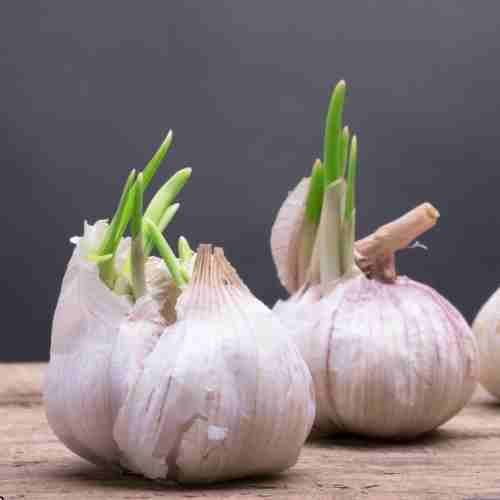
Garlic is an incredibly versatile and rewarding crop to grow, whether you have a spacious garden or a small balcony. Known for its robust flavor and numerous health benefits, garlic is a staple in many cuisines around the world.
Growing your own garlic means having a steady supply of fresh cloves to add to your cooking, enhancing flavor while also reaping the rewards of your hard work.
In this guide, we’ll explore all the ins and outs of growing garlic, providing you with essential tips and strategies to cultivate this aromatic crop successfully.
Get our Gardening Buddy and find veggies that fit your conditions best.
You Can Grow It!
Planting Garlic
Planting garlic is straightforward and requires minimal effort. Start by obtaining certified, disease-free garlic bulbs from a garden center or reputable online supplier. Avoid using supermarket garlic, as it may be treated to prevent sprouting and could carry diseases.
Steps to Plant Garlic:
- Separate the Bulbs: Gently break apart the garlic bulb into individual cloves, keeping the papery husk intact.
- Choose the Best Cloves: Select the largest cloves for planting, as they will produce the healthiest plants and biggest bulbs.
- Planting Depth and Spacing: Plant each clove with the pointed end facing up, about 2 inches deep. Space them 4 to 8 inches apart in rows that are 6 to 12 inches apart.
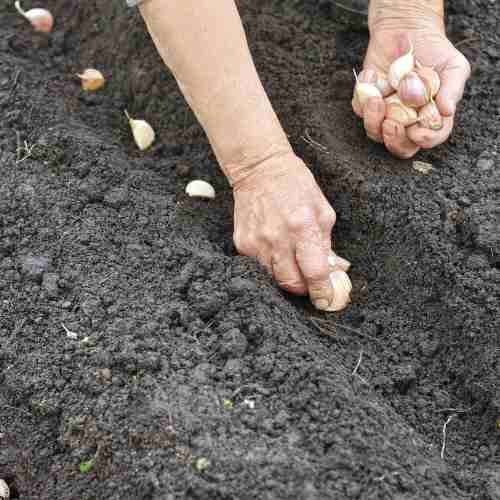
Growing Garlic
Garlic thrives in a sunny location with fertile, well-draining soil. It’s a cold-hardy plant that actually benefits from a period of chill, which helps in bulb development.
Types of Garlic:
- Hardneck Garlic: Best suited for colder climates, hardneck varieties produce fewer but larger cloves and have a robust flavor. They also produce edible scapes (flower stalks) in the spring.
- Softneck Garlic: More common in supermarkets, softneck varieties have more cloves per bulb and store longer. They prefer milder climates but can be grown in colder areas with some winter protection.
When to Plant Garlic
The optimal time to plant garlic is in the fall, about 6 to 8 weeks before the ground freezes. This timing allows the cloves to establish roots before winter sets in.
- Cold Climates: Plant between late September and November.
- Mild Climates: If you live in a warmer region, you can plant garlic in late fall or even in early spring, but fall planting usually yields better results.
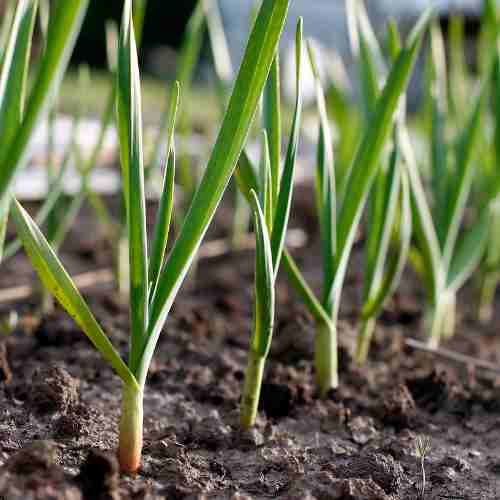
Preparing the Soil for Garlic
Garlic prefers rich, well-draining soil with a pH between 6.0 and 7.0. Preparing the soil properly will set the foundation for a healthy garlic crop.
Soil Preparation Steps:
- Clear the Area: Remove weeds and debris from the planting site.
- Add Organic Matter: Incorporate compost or well-rotted manure into the soil to enhance fertility.
- Ensure Good Drainage: If your soil is heavy clay or tends to retain water, consider planting in raised beds or adding sand to improve drainage.
How to Grow Garlic in a Container
If space is limited or you prefer container gardening, garlic can be successfully grown in pots.
Container Gardening Tips:
- Choose the Right Pot: Use a container that’s at least 12 inches deep with adequate drainage holes.
- Soil Mix: Fill the pot with high-quality, well-draining potting soil mixed with compost.
- Planting: Plant the cloves as you would in the ground, with the pointed end up and spaced about 4 inches apart.
- Location: Place the container in a spot that receives at least 6 hours of sunlight daily.
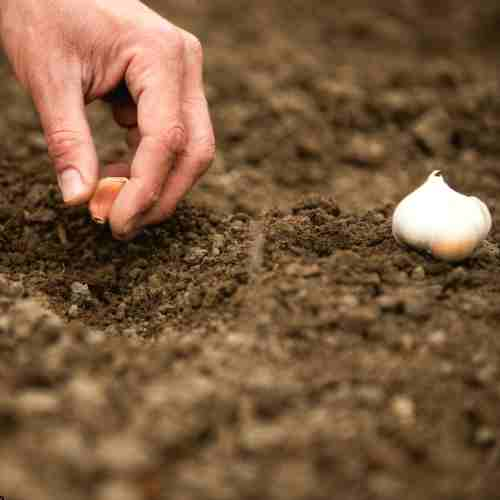
How to Care for Garlic
Garlic is a low-maintenance plant, but proper care will ensure a bountiful harvest.
Watering:
- Regular Watering: Keep the soil evenly moist but not waterlogged during the growing season.
- Reduce Watering: Once the leaves start to yellow and die back, reduce watering to allow the bulbs to mature.
Fertilizing:
- Initial Feeding: Work a balanced fertilizer or bone meal into the soil at planting time.
- Additional Feeding: In early spring, side-dress with compost or use a nitrogen-rich fertilizer to promote healthy leaf growth.
Weeding:
- Keep It Clean: Garlic doesn’t compete well with weeds, so regularly remove any weeds that appear.
- Mulching: Apply a layer of mulch to suppress weeds and retain soil moisture.
Pest and Disease Management:
- Natural Deterrent: Garlic naturally repels many pests but watch out for common issues like onion white rot or rust.
- Crop Rotation: Avoid planting garlic in the same spot each year to prevent soil-borne diseases.
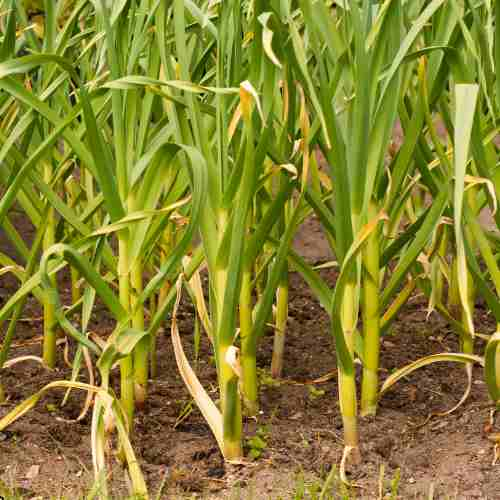
Harvesting Garlic
Garlic is typically ready to harvest in mid to late summer when the lower leaves have turned brown, but the upper leaves are still green.
Harvesting Steps:
- Check for Maturity: When about half of the leaves have died back, it’s time to harvest.
- Gently Dig Up Bulbs: Use a garden fork or shovel to carefully lift the bulbs from the soil.
- Handle with Care: Avoid bruising or damaging the bulbs, as this can affect storage life.
Storing Garlic
Proper curing and storage will allow you to enjoy your homegrown garlic for months.
Curing Process:
- Clean the Bulbs: Brush off excess soil but do not wash the bulbs.
- Drying: Lay the garlic out in a single layer in a dry, shaded area with good air circulation for 2 to 3 weeks.
- Trim and Store: Once cured, trim the roots and cut the stalks about an inch above the bulb (unless you plan to braid them).
Storage Tips:
- Ideal Conditions: Store garlic in a cool, dry place with temperatures between 60-65°F (15-18°C).
- Avoid Moisture: Do not store garlic in plastic bags or refrigerated areas, as moisture can lead to rot.
- Longevity: Hardneck varieties store for about 3 to 5 months, while softneck varieties can last up to 8 months.
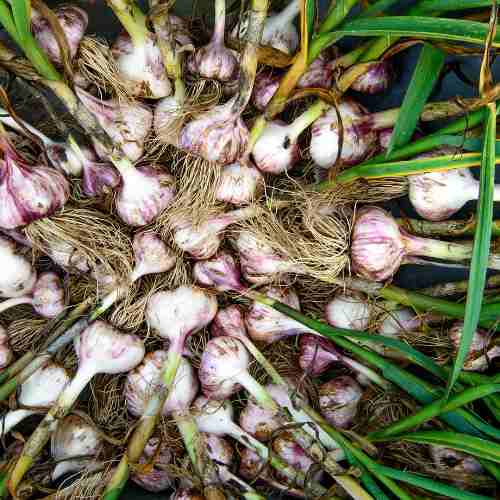
Garlic is Great for Cold Climates
Garlic is a cold-hardy plant that thrives in colder climates, making it an excellent choice for gardeners who experience harsh winters.
In fact, garlic grows best when planted in the fall, allowing it to establish roots before winter sets in. The cold period is actually beneficial for garlic, as it helps in the formation of large, flavorful bulbs.
If you live in an area with cold winters, garlic can be one of the best crops to plant since it doesn’t just survive but actually benefits from the chilly conditions.
Once the snow melts and spring arrives, the garlic will continue growing robustly, leading to a bountiful garlic harvest by summer.
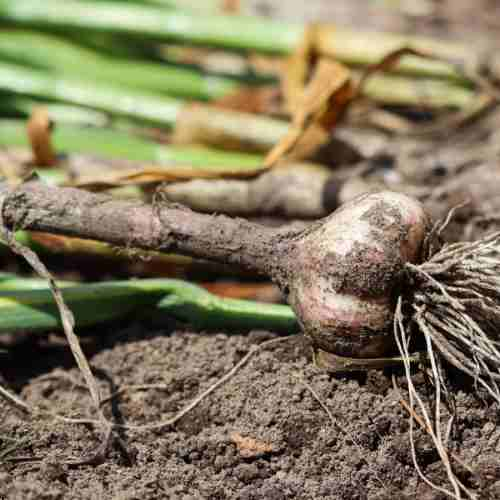
Garlic Can Fully Grow Indoors
If you lack outdoor space or live in a climate that doesn’t accommodate garlic well, you can still grow this flavorful crop indoors.
Garlic greens, which have a milder taste than full garlic cloves, are particularly easy to grow in small containers on a sunny windowsill. With the right amount of light—preferably six hours of direct sunlight or supplemental grow lights—garlic can flourish inside.
Planting cloves in a pot with well-draining soil will yield a steady supply of garlic greens for garnishes or cooking. Although growing full bulbs indoors is more challenging due to the need for cooler temperatures, it’s still possible with careful management of conditions.
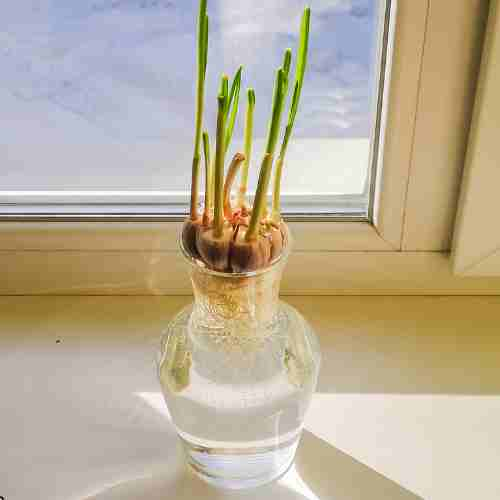
Garlic Fits in Small Spaces
Garlic is a perfect crop for small-space gardening, as it requires very little room. Each garlic clove, when planted, grows into a full bulb, allowing gardeners to make the most out of minimal space.
You can easily plant garlic in raised beds, small garden plots, or even containers. This makes garlic an ideal choice for urban gardeners or those with limited outdoor space.
Raised beds are particularly useful, as they help with drainage and allow you to control the soil quality more easily. Since garlic doesn’t grow very tall, it fits well with other plants, letting you maximize your garden’s productivity.
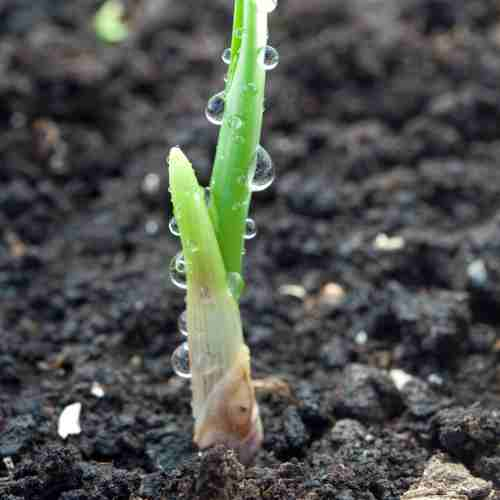
Garlic is a Low Maintenance Plant
One of the most appealing qualities of garlic is its low-maintenance nature.
Once you plant the cloves, garlic requires very little care beyond occasional weeding and ensuring the soil remains moist but not waterlogged. A layer of mulch can help retain moisture and reduce the need for frequent watering, while also suppressing weeds.
Unlike many other crops that need constant fertilization and pruning, garlic is content with minimal intervention, making it a great choice for beginner gardeners or those with busy schedules. With just a little initial care, garlic will reward you with a bountiful harvest.
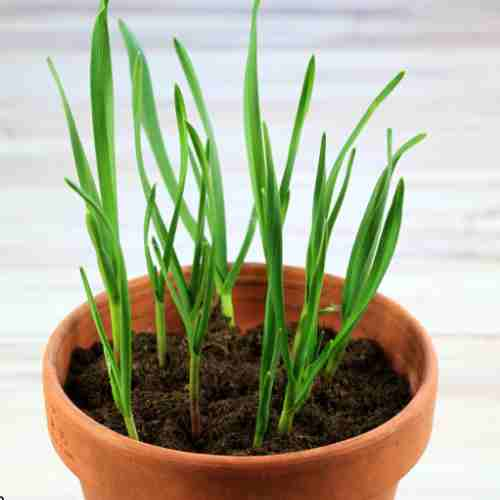
Garlic Does Not Need a Lot of Sun
Garlic is relatively tolerant of lower light conditions compared to many other vegetables. While it does best in full sun, receiving six to eight hours of direct sunlight a day, garlic can still grow well in partially shaded spots.
This flexibility makes garlic a good choice for gardens that don’t get full sun all day or for planting alongside taller crops that might cast some shade. By positioning your garlic in an area that gets morning sun and afternoon shade, you can still enjoy a healthy crop of flavorful bulbs without worrying too much about sunlight requirements.
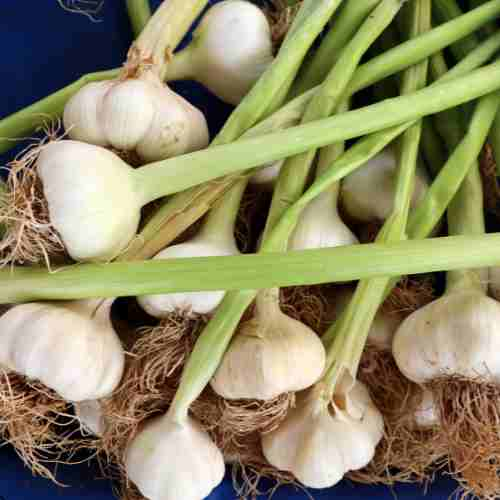
Garlic is a Natural Pest Deterrents
Garlic is not only easy to grow but also helps improve the health of your garden as a natural pest deterrent.
The strong smell of garlic is known to repel many common pests, such as aphids, ants, and even some types of beetles. Planting garlic alongside other vegetables can help protect those crops from infestations, reducing the need for chemical pesticides.
Additionally, garlic’s natural fungicidal properties can help prevent certain plant diseases. Companion planting with garlic is an effective, organic way to manage pests and diseases in your garden while enjoying a crop that enhances your cooking.
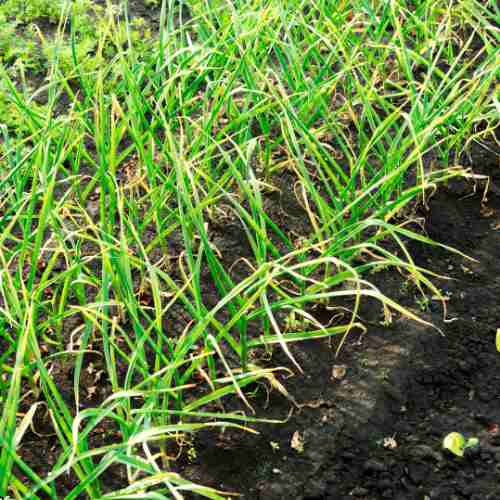
Choosing the Right Garlic Variety
When it comes to growing garlic, choosing the right variety is key to a successful harvest. There are two main types of garlic: hardneck and softneck. Hardneck garlic is best suited for colder climates and produces scapes, which are edible flower stalks that add a delicious garlicky flavor to dishes.
Softneck garlic, on the other hand, is ideal for warmer climates and tends to have a longer shelf life. Consider your local climate and how you intend to use the garlic when selecting a variety.
Hardneck varieties are generally easier to peel and have a more complex flavor, while softneck varieties are better for braiding and long-term storage.
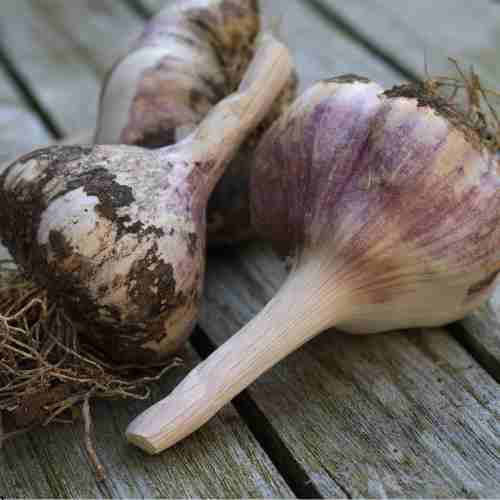
Companion Planting with Garlic
Garlic is an excellent companion plant that can help improve the overall health of your garden. Its natural pest-repelling properties make it a great partner for many vegetables, including tomatoes, peppers, carrots, and brassicas.
Planting garlic near these crops can help deter pests like aphids, spider mites, and cabbage loopers.
However, it’s best to avoid planting garlic near legumes, such as beans and peas, as it can inhibit their growth. By strategically placing garlic throughout your garden, you can create a natural defense system that reduces the need for chemical pesticides and promotes a healthier growing environment for all your plants.
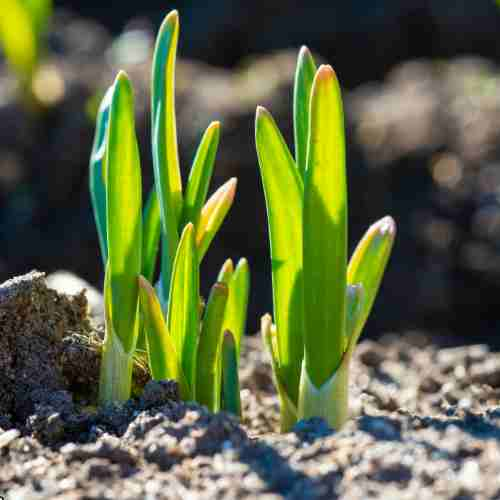
Find the Vegetables that are Best for you
Growing garlic is an incredibly rewarding gardening experience, providing a flavorful harvest that can enhance countless dishes.
Whether you have a large outdoor garden, a small patio, or even just a windowsill, garlic’s versatility and low-maintenance nature make it accessible to almost anyone.
Its ability to grow in cold climates, thrive indoors, and fit into small spaces makes garlic an ideal crop for a variety of situations. Plus, its natural pest-repelling properties can benefit your entire garden.
By following the simple tips outlined in this guide, you can successfully grow garlic and enjoy the satisfaction of harvesting your own fresh, aromatic cloves.
Get our Gardening Buddy and find veggies that fit your conditions best.
You Can Grow It!
Partners and Sponsors
We are forever grateful to our partners and sponsors. Send an email to team @ strongecho.com and let’s see how we can grow each other’s impact!





